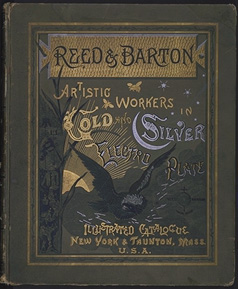 Marketing in the Modern Era: Trade Catalogs and the Rise of 19th-Century American Advertising |
|
About the Exhibit |
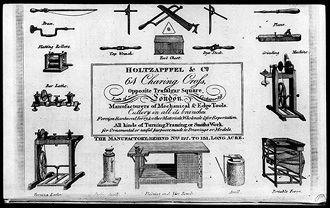 Introduction
IntroductionThe 19th century was an era of extraordinary growth and change in American history. Dramatic expansion in population, wealth, income, and territory were matched by an unprecedented increase in consumer markets, manufacturing, and technological innovation. The railroad provided access to potential customers near and far, new technology revolutionized agriculture and manufacturing, and the rise of factories forever changed the lifestyle of the American laborer. While the first half of the century saw the beginning of industrialization, the latter half, especially following the Civil War, ushered in a period of modernization that brought with it tremendous developments in advertising. New advances in printing technology, including mechanization and lithography, simultaneously reduced production costs and improved the visual quality of printed advertising materials. Among the most widespread of the emerging forms of advertising was the trade catalog.
For the purpose of this exhibition, a trade catalog will be defined as a multi-page listing of manufactured or produced items offered for sale by stock number or specific name. Items in the catalog may or may not be illustrated, priced, or described in further detail. The term "catalog" in this context is reserved for publications issued independently and does not include advertising in periodicals or in the front or back of bound books. The Baker Library does have extensive holdings of other advertising materials, including trade cards, posters, broadsides, flyers, and circulars, and some examples of these are also included in the exhibition to illustrate the role of the trade catalog in the broader context of 19th-century American advertising history. |
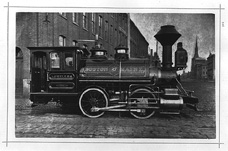 Growth of Major Industries Growth of Major Industries
Perhaps the two most important new industries to emerge in the 19th century involved the development and production of steam engines and railroads. The former was responsible for driving much of the new machinery and the latter for ensuring that no area of the United States was inaccessible to the manufacturer. New technology also dramatically changed the scale of production and revolutionized traditional fields like agriculture and textile manufacturing. Jobs that might have taken several laborers weeks to complete could be done in hours with the help of new implements and machinery. To compete in the rapidly expanding markets, businesses would have to embrace the new techonology. Trade catalogs brought word of these advances to the market, wherever and whatever it might be. More Images on This Topic |
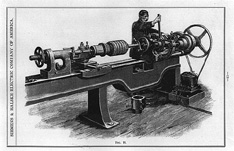 Emergence of Supporting Industries Emergence of Supporting IndustriesAlong with the growth of major industries came the emergence of a host of new manufacturers to support them, providing everything from pipes and fittings to machine parts and small engines. In some cases this meant that already existing establishments found new niches like the production of woven covers for electrical wiring or the printing of railway tickets and advertising materials. But it also meant the introduction of original products and inventions like electrical surge protectors and tools for machine maintenance, as well as innovative dies and equipment to improve the production of the machines themselves. There was a trade catalog to herald the arrival of virtually every new manufacturer, every new product, and every new invention that came into the market. More Images on This Topic |
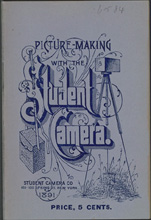 Leisure Activities and Pastimes Leisure Activities and PastimesAs the 19th century progressed, urbanization and industrialization altered the very structure of American society. By mid-century, workers lives were becoming more routine and relief from monotony was sought through new types of activities. In addition, leisure was no longer exclusively identified with a leisured class but was beginning to relate to a more widespread segment of the population. A sporting goods industry emerged in response to crazes for sports like lawn tennis, archery, gymnastics, and bicycling, while hobbies such as gardening and photography flourished. There were also new options for home entertainment as advancements in technology made items like the piano more affordable, inventions like Edison's phonograph brought recorded music into the home, and developments in printing and binding made books morely widely available. Elaborately produced and beautifully illustrated trade catalogs were made to solicit the business of both the retailer and the consumer at home. More Images on This Topic |
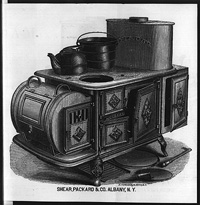 Consumer and Household Goods Consumer and Household GoodsAs industrialization got under way in the first half of the century, there was a shift from the localized general merchant dominating the market to national manufacturers advertising their wares to retailers and home consumers across the country. By the 1870s the general economy had expanded enough to make the American working people, in addition to the wealthy professional and business classes, consumers. In response to this burgeoning market, American manufacturers began to produce and distribute household and consumer goods on an unprecedented scale. Sewing machines and stoves were among the earliest and most frequently produced items while products like refrigerators and bathtubs represented the new freedom and improvement in quality of life that advances in technology and industry promised to American households. In addition, the marketing of a tremendous variety of domestic goods and luxury products, including clothing, china, silverware, and decorative objects, helped to define the consumer culture. More Images on This Topic |
|
Exhibit Directory |
Selected Bibliography |
Web Resources |
Contact Information Other Exhibits | Historical Collections | Baker Library Home |

